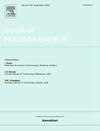Refining LBM accuracy and efficiency for neutron diffusion: Integrated strategies for model configuration and boundary treatment
IF 2.3
3区 工程技术
Q1 NUCLEAR SCIENCE & TECHNOLOGY
引用次数: 0
Abstract
A solution framework for neutron diffusion equations based on the higher-order lattice Boltzmann method (HLBM) was constructed, with detailed unit conversion procedures for this problem being systematically presented. The influences of relaxation time, discrete velocity models, and boundary condition treatment schemes on numerical performance were comprehensively examined. A nonlinear regulatory relationship between relaxation time and computational domain dimensions was investigated, while the effects of D2Q4, D2Q5, and D2Q9 discrete velocity models on solution accuracy and computational efficiency were comparatively analyzed. A novel boundary condition processing strategy was proposed and validated through comparison with analytical solutions. Research findings indicate that when the relaxation time is set within the range of 1.2 to 1.4, the system achieves the minimum computational error, and the proposed size-dependent dynamic optimization criterion for relaxation time has been proven to effectively reduce computational errors. Regarding discrete models, the D2Q4 model demonstrated superior comprehensive performance, exhibiting 53% and 83% reductions in mean relative errors compared with D2Q9 and D2Q5 models respectively, while achieving 42% faster convergence rates than both counterparts. The novel reflective boundary treatment scheme is demonstrated to exhibit a maximum relative error of 0.13%, while the zero boundary condition treatment scheme achieves a maximum relative error of 0.042%, with no significant increase in computational complexity. The reliability of both schemes is rigorously validated. These research outcomes provide quantitative parameter optimization criteria and innovative boundary treatment schemes for neutron diffusion simulations in nuclear reactors using HLBM, demonstrating significant engineering applicability.
提高中子扩散的LBM精度和效率:模型配置和边界处理的集成策略
建立了基于高阶晶格玻尔兹曼方法(HLBM)的中子扩散方程求解框架,系统地给出了该问题的详细单位转换过程。全面考察了松弛时间、离散速度模型和边界条件处理方案对数值性能的影响。研究了松弛时间与计算域维数之间的非线性调节关系,对比分析了D2Q4、D2Q5和D2Q9离散速度模型对求解精度和计算效率的影响。提出了一种新的边界条件处理策略,并与解析解进行了对比验证。研究结果表明,当松弛时间设置在1.2 ~ 1.4范围内时,系统的计算误差最小,所提出的尺寸相关的松弛时间动态优化准则被证明可以有效地减小计算误差。在离散模型方面,D2Q4模型表现出优越的综合性能,与D2Q9和D2Q5模型相比,D2Q4模型的平均相对误差分别降低了53%和83%,而收敛速度比两者都快42%。该方法最大相对误差为0.13%,而零边界条件处理方案的最大相对误差为0.042%,且计算复杂度没有显著增加。对两种方案的可靠性进行了严格验证。这些研究成果为高通量弹道导弹核反应堆中子扩散模拟提供了定量参数优化准则和创新的边界处理方案,具有重要的工程适用性。
本文章由计算机程序翻译,如有差异,请以英文原文为准。
求助全文
约1分钟内获得全文
求助全文
来源期刊

Annals of Nuclear Energy
工程技术-核科学技术
CiteScore
4.30
自引率
21.10%
发文量
632
审稿时长
7.3 months
期刊介绍:
Annals of Nuclear Energy provides an international medium for the communication of original research, ideas and developments in all areas of the field of nuclear energy science and technology. Its scope embraces nuclear fuel reserves, fuel cycles and cost, materials, processing, system and component technology (fission only), design and optimization, direct conversion of nuclear energy sources, environmental control, reactor physics, heat transfer and fluid dynamics, structural analysis, fuel management, future developments, nuclear fuel and safety, nuclear aerosol, neutron physics, computer technology (both software and hardware), risk assessment, radioactive waste disposal and reactor thermal hydraulics. Papers submitted to Annals need to demonstrate a clear link to nuclear power generation/nuclear engineering. Papers which deal with pure nuclear physics, pure health physics, imaging, or attenuation and shielding properties of concretes and various geological materials are not within the scope of the journal. Also, papers that deal with policy or economics are not within the scope of the journal.
 求助内容:
求助内容: 应助结果提醒方式:
应助结果提醒方式:


